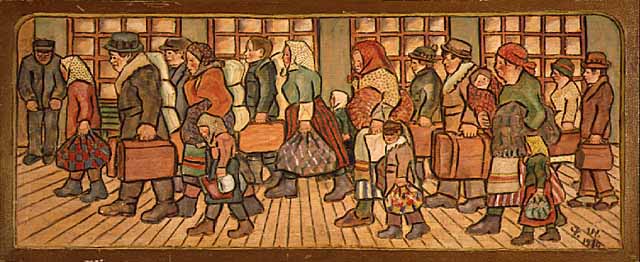
In recent months, the Syrian immigration crisis has been in the headlines in the United States as well as other foreign countries. But a question arises: are we also letting in other immigrants under the radar without having major ethical debates? Are these migration stories much more complex than they appear on the surface?
“Pre-Occupied Liquid Spaces: The Journey of Italian Emigrants Abroad and Foreign Immigrants Toward Italy,” was presented on Wednesday, April 20 by Dr. Teresa Fiore of Montclair State University. She discussed the horrors of past and present immigration issues that cloud the Mediterranean region. Some migrants still cross dangerous conditions to reach Italy in hopes for a better quality life or career opportunity.
Traversing land and sea can be a matter of life or death for these hopeful immigrants leaving wars, famines, persecution and lack of opportunities. According to Fortress Europe, from 1988 to 2016, 13,318 people died while crossing the Sicily Channel, with 9,965 lost at sea. The story of today’s foreign immigration towards Europe, and Italy specifically, is strongly marked by undocumented routes, even though many communities are integrated in the social fabric of the country.
Yet, as Fiore said, few people are aware more than 500,000 Italian natives have overstayed their visas in the United States and elsewhere and live as undocumented immigrants but have a higher level of education and pursue different career paths. Some accept simple jobs as long as they can they can find job opportunities that allow them to improve their economic condition.
A video excerpt of “Once We Were Strangers” by Emanuele Criarlese suggests how some Italian immigrants may even travel across the Atlantic using a simple raft and minimal resources to reach New York City. Though a dramatized rendition, this story of an Italian young man’s struggle to arrive in a more promising land documents many modern survival narratives that aren’t well known by Americans.
While there are Italians who look for opportunities abroad, foreign immigrants cross borders to find opportunities in Italy and Europe: yet they really use boats that are insufficient to cross large bodies of water such as the Mediterranean with many other passengers, and more often than not they don’t know how to drive these boats nor how to swim. Their crossing is risky and sadly, fatal for many.
Their stories resonate with Americans as this country also experiences the arrival of undocumented migrants.
“Like the southwest border of the United States, travelers cross the deserts over 100 degrees, in packed vans,” Fiore said.
Italians themselves have traveled as undocumented immigrants in the past and today they overstay. Yet, a large number of them come via legal visas to find opportunities in academia, among other sectors. From the 1980s to ‘90s, a number of ‘brain-drain’ Italians left Italy in search of intellectual opportunities to become doctors, lawyers and higher paying jobs that require research. Therefore, their “self-perception, as well as the perception of Italian on the part of Americans is different than that of Italian immigrants at the turn of the century,” Fiore said.
Fiore is part of the population that wanted to pursue a job in higher education. She came over by herself. Thanks to her position as Inserra Chair in Italian American Studies at Monclair State University, she utilizes her career as a way to stay connected to her heritage and promote Italian culture.
Ornella Mazzuca, Associate Professor of Spanish at Dutchess County Community College, also of Italian lineage, appreciated the main goal of the presentation. Sharing an accepting socio-cultural view, Mazzuca states “it’s not an invasion, it’s a cycle.”
Pierra Castelnovo, local volunteer, is aware of the issue of Italian immigration and how it seems to appear over time in economic recessions. However, “It’s easy to deny the whole thing,” Castelnovo said. Casting aside other culture’s migration stories while others receive more attention seems to be an issue many are not aware of in the United States. But regardless of ethnic background, many refugee and migration stories share common roots in fleeing poverty or challenging situations, and seeking opportunities to rise in economic status.
Indeed, Italians overstaying the United States do have many obstacles to bear when they leave their homeland, although it is not comparable to the challenges faced by those who cross borders without papers. Many may not reach a more satisfying life economically but are searching. Ancestors who passed through Ellis Island over a century ago must have bore the same mindset that hoped for comfortable standards of living and working in more alluring conditions.
